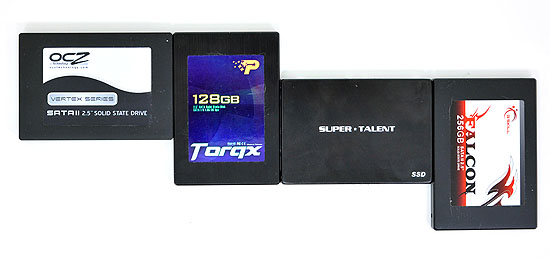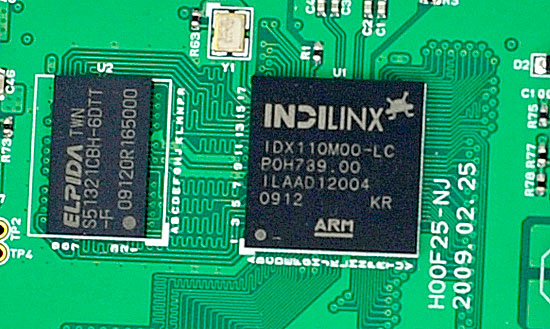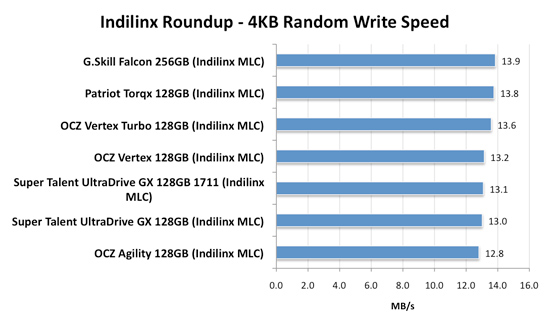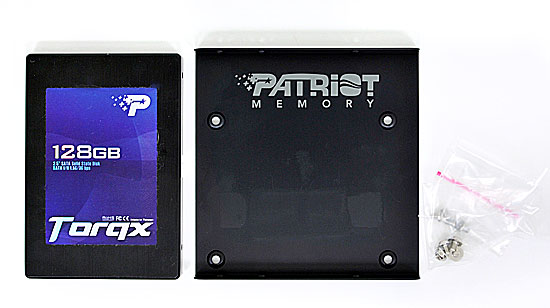The SSD Relapse: Understanding and Choosing the Best SSD
by Anand Lal Shimpi on August 30, 2009 12:00 AM EST- Posted in
- Storage
All Indilinx Drives Are Built Alike
G.Skill, OCZ, Super Talent and Patriot all sent their Indilinx MLC drives in for review. If you take the drives apart you see that most are the very same on the inside, despite differences externally:


From Left to Right: OCZ Vertex Turbo, OCZ Agility, Patriot Torqx, G.Skill Falcon and Super Talent UltraDrive GX. Only the Super Talent drive uses a different PCB design.
Even the packaging doesn’t appear to vary much between manufacturers; that part I don’t really understand. All that seems to change is the artwork on the outside.
There are some minor differences between drives. Patriot ships its Torqx with a 2.5” to 3.5” drive bay adapter, a nice addition. The Torqx also comes with a 10 year warranty, the longest of any Indilinx based manufacturer. OCZ is next with a 3 year warranty, followed by Super Talent and G.Skill at 2 years.
Indilinx is still a very small company so it relies on its customers to help with validation, testing and even provide feedback for firmware development. As far as I can tell, every single Indilinx customer gets the same firmware revisions. Some vendors choose to rename the firmware revisions, while others do not. OCZ calls its latest stable firmware 1.30, while G.Skill, Super Talent and Patriot call it 1571.

The Indilinx Barefoot controller (right), powered by an ARM core.
Of all the Indilinxites, OCZ and Super Talent work closest with the controller manufacturer. In exchange for their help in manufacturing and validation, OCZ and Super Talent also get access to the latest firmwares earlier than the rest of the manufacturers. Ultimately all manufacturers will get access to the same firmware, it just takes longer if you’re not OCZ or Super Talent.
You no longer need to use a jumper to upgrade your firmware, provided that you’re already running fw revision 1275 or later. If you have a previous version you’re pretty much out of luck as you need to upgrade to 1275 first before upgrading to anything else, and none of the manufacturers make it easy to do. Some don’t even offer links to the necessary firmware you’d need to jump to 1275. Thankfully pretty much anything you buy today should come nearly up to date, so this mostly impacts the original customers of the drive.
Performance, as you’d expect, is the same regardless of manufacturer:

There's normal variance between drives depending on the flash/controller, that's why the OCZ Vertex is slower than the Patriot Torqx here but faster than the Super Talent UltraDrive GX. The manufacturer and size of the flash has more to do with determining performance. Samsung is used on all of these drives but the larger the drive, the better the performance. The 256GB model here will always be faster than a 128GB drive, which will always be faster than a 64GB, etc...
All of the drives here use the same firmware (1571) except for one of the Super Talent drives. That drive is using the beta 1711 firmware with TRIM support that was pulled.
When it comes to the best overall package, I’d say Patriot’s Torqx is the nicest for a desktop customer. You get a 3.5” adapter bracket and a 10 year warranty (although it’s difficult to predict what Patriot’s replacement strategy will be in 10 years).

The Patriot Torqx bundle, complete with a 2.5" to 3.5" adapter.
Prices vary a bit between manufacturers, although most of the more expensive drives here have a $30 rebate to bring their prices in line:
| Price for 128GB | |
| Corsair Extreme Series | $384.00 |
| OCZ Agility | $329.00 |
| OCZ Vertex | $369.00 |
| OCZ Vertex Turbo | $439.00 |
| Patriot Torqx | $354.99 |
OCZ does do some unique things that the other manufacturers don’t such as deliver an overclocked drive (Turbo) and a drive with slower flash (Agility). There’s a Mac Edition of the Vertex, unfortunately it’s no different than the regular drive - it just has a different sticker on it and a higher pricetag.










295 Comments
View All Comments
IPL - Monday, August 31, 2009 - link
I first started reading anandtech when I got seriously interested in SSDs and honestly, you write the best SSD articles around! Thank you for all the help you gave me in deciding which SSD to buy.I ordered online the new G2 last week and should be getting it in a few days. I live in Greece and the re-launched G2 has been available here for about a week now.
I am planning on replacing the HDD on my Feb 08 Macbook Pro (last refresh pre-unibody) as soon as I get it. I am just a consumer with a little bit of knowledge on tech but not a pro at all. I just thought of asking all a few questions that I have pre-drive swapping.
1. Will TRIM be supported on macs? Any news if and when?
2. When then new TRIM firmware is out, do I have to just install the firmware or will I need to format everything and start from fresh in order to get it to work?
3. I have bought a 2,5'' SATA USB enclosure in order to put my G2 in there first, connect it to the laptop via the USB and install Snow Leopard from there. After I am done, I will remove the G2 from the enclosure, swap the drives and hopefully, everything will be working. Does this sound logical? I am worried about the h/w drivers to be honest.
Thanks in advance for your help. I will post some non-scientific time results as soon as get this done. Cant wait.
gstrickler - Monday, August 31, 2009 - link
The simplest way to swap the HD on most Mac OS machines is:1. Connect both the old and the new drive to the machine (internally or in an external USB or FireWire case).
2. Use Disk Utility (included in Mac OS X) to set the appropriate partitioning scheme (GUID for Intel based Macs, Apple Partition Scheme for PPC Macs) on the new drive.
3. Partition and format the new drive.
4. Use Carbon Copy Cloner (shareware) to clone the old drive to the new drive.
5. Try booting off the new drive. Note that PPC Macs can't boot from USB drives, but Intel based Macs can. All PPC and Intel Macs with a built-in FireWire port can boot from a FireWire drive.
6. If not already done, physically swap the drives to the desired locations, boot and set the preferred startup drive.
IPL - Tuesday, September 1, 2009 - link
Awesome, thanks for the help.I have checked Carbon Copy Cloner and it is already one of my options. Never tried it before but looked easy enough.
I havent decided yet which way I will do it (fresh install or clone existing drive) but I will make my mind up when everything is ready!
Anand Lal Shimpi - Monday, August 31, 2009 - link
Thank you for reading and saying such wonderful things, I really do appreciate it :)1) I don't believe TRIM is presently supported in Snow Leopard. I've heard that Apple may be working on it but I don't think it's there now.
2) From what I've seen, it should preserve your data. It's still worth backing up just in case something ridiculous happens.
3) What you're describing should work, although if I were you I'd just swap the drives and install. Hook your old drive up via USB and pull any data you need off of that.
Take care,
Anand
sunbear - Monday, August 31, 2009 - link
Another fantastic article. I just wanted to draw your attention to recent reports that the majority of currently available laptops (including the MacBookPro) are unable to support transfer rates greater than SATA-150 (http://www.hardmac.com/news/2009/06/16/new-macbook...">http://www.hardmac.com/news/2009/06/16/...imited-1....Since most laptops can't even use the full performance of these SSD's, do you have any recommendation regarding which one would be the best bang-for-the-buck to speed up a laptop?
Personally, I am interested in putting SSD's in a laptop not only for the speed improvements, but I'm also hoping that it reduces the amount of heat that my laptop will put out so that I can finally find a laptop that you can use comfortably on your lap!
Incidentally, it would be really great if laptop reviewers checked to see if they could comfortably work with a laptop at full load on their lap as a standard test.
Anand Lal Shimpi - Monday, August 31, 2009 - link
Even on a SATA-150 interface, you're generally only going to be limiting your sequential read speed and perhaps your sequential write speed a bit. Random read/write speeds don't really go above 60MB/s so you're fine there.They recommendations remain the same; Intel at the top end, anything Indilinx MLC to save a bit. If anything, a SATA-150 interface makes the Intel drive look a bit better since its 80MB/s sequential write limit isn't as embarrassing :)
Take care,
Anand
Dobs - Monday, August 31, 2009 - link
I hope Seagate / Western Digital etc. bring even more innovation / competition in SSD's next year... and not just Enterprise products.And one thing I don't fully understand is why there aren't more dedicated 3.5" drives. Patriot has the adapter but what about the rest??? No money in desktops anymore???
Anand Lal Shimpi - Monday, August 31, 2009 - link
OCZ is making a 3.5" Vertex drive, waiting on it for review :)Take care,
Anand
kisjoink - Monday, August 31, 2009 - link
Now that the good performing SSDs are half the price of last year, I'd really like to see a 2xSSD in RAID 0 article!mgrmgr - Monday, August 31, 2009 - link
I second the request for a 2xSSD RAID-0 article...with specific discussions about which applications it benefits (Photoshop?) and which ones it doesn't.Before October 22nd when I buy a new Win7 computer? Please. :-)